Monday, February 16 2015
Depending on where you live, spring is in the air either a little or a lot, or maybe not at al Hibernation is a deep sleep, usually occuring in colder, snow covered climates in northern states. Snakes don't actually sleep in brumation, but their bodies acclimate to a lower temperature, their metabolism slows, and they become less active and less inclined to feed. Brumation or hibernation is necessary for breeding. If male snakes don't cool down at some point during the year, they most likely would not be able to produce fertile sperm.
Generally, rattlesnakes emerge from true hibernation in March or April, or when the average daytime temperatures reach and remain about 60 degrees Fahrenheit and higher. In the spring, keep in mind that emerging snakes are hungry, thirsty, and ready for love! With spring approaching, follow the Boy Scout motto and be prepared. Just like the US Border Patrol, US Forestry Service, hunters, hikers, fishermen, ranchers, surveyors, realtors, landscapers, and thousands of treasure hunters, wear snake gaiters or snake boots and you'll know you're protected when in the desert or woods. Don't take a chance! Wednesday, January 21 2015
Mark your calendars for these dates and cities:
Visit the GPAA website for more details and online registration. See you there! Monday, January 19 2015
PI (pulse induction) detectors work a bit differently than the more common VLF (very low frequency) detectors by putting magnetic field energy into the ground and then switching off and waiting a short period before they start to look for a response. This makes them better at handling ground mineralization than a VLF detector because during that short delay the magnetic response of iron trash minerals that you don't want to find dies out. VLF detectors do not as easily cancel out ground mineralization the way a PI metal detector can do. Kevin Hoagland, Executive Director of Development for the Gold Prospectors Association of America recently field tested the Garrett ATX Deepseeker. Below is an excerpt of Kevin's review: "My first impression of the ATX was that it's compact, heavy and built like a tank, and all connections are waterproof. Battery installation is simple. The ATX uses 8 AA batteries in two 4-battery drop-in packs and comes with an 8-slot AA battery charger. Not only does this detector come with a rugged case and carry bag, but also everything else you need to get out detecting. The units ships with the 20 inch mono coil already installed. It is also shipped with headphones that are screwed into the back of the unit. I slipped my arm into the adjustable cuff, and grabbed the control pod. There was no unnecessary torque on
As with most large PI detectors, the Garrett ATX Deepseeker Metal Detector is not light, and the waterproofing adds extra weight. Were it not for the ergonomic design, detectorists not accustomed to the weight of these machines might tire quickly. The supplied sling is easy to use, adjust, and offers a fair way to alleviate some of the weight, but I found it uncomfortable for long periods of use. Many avid detectorists use after-market harness systems, so you may want to check out those options if you plan to spend long days detecting. In the field, the Deepseeker performed exceptionally well. The unit demonstrated almost complete immunity to all but the worst hot rocks I encountered. The ground balance and multi-speed ground tracking worked great, but I found that I rarely used the ground tracking as the ATX handled most of the soil mineralization in the OFF position. The threshold was quick to respond to ground changes and a simple ground balance was all that was needed to bring the ATX back into maximum depth and sensitivity. The Iron Check works well, maybe even too well! I dig everything no matter what and I have had a very successful nugget-hunting career doing just that. I have found good targets under junk on many occasions. Be careful and mindful that gold, like junk, is where you find it and there is no law of detecting that states there will be no gold under junk! Regardless of your level of detecting expertise, it will take some time to get comfortable with all the functions and navigating the menus of the ATX. With multi-button presses to access some functions, it's important to take time to learn the machine well beyond the quick-start level. Overall, Garrett has created a PI detector that is extremely well made with solid functionality. The ATX offers great value for your dollar. Garrett has again carved a niche in the metal detector market, and the ATX perfectly has met the needs expressed by detectorists worldwide..." You can find Kevin's complete field test review on pages 16-19 of the November/December 2014 issue of Gold Prospectors Magazine, or download the .pdf here. You can also get more information and watch a video of the Garrett ATX Deepseeker Metal Detector on this website. Sunday, January 11 2015
"... The Desert Fox ships in an Action Packer case that is the storage, transport, and water container unit. It provides excellent protection for the Fox while giving you a true compact recirculating unit that can be transported easily. Unpacking the container was simple and for those of us that spend little time looking at the way something comes out of a container, the manufacturer has included a photo in the manual to show you how to repack the unit so it's back to being travel-ready in just a few seconds. In the container you will find:
Setup takes just a few moments. The wheel frame is a single point A-frame that sits perfectly in place in the container and allows you a stable, easy-to-set-up base for the spiral unit. The A-frame construction also allows the unit to be set up directly in a stream. Stand the A-frame in the container, lift the drive unit to a beginning angle, slide the double-wall wheel into the slot on the drive motor, attach the spray bar, fill with water, hook up to a 12-volt power supply (not included), and after a couple of fine tuning adjustments, the Desert Fox is ready to start running your concentrates. Total time from cased to running is about two minutes! The A-frame mounted drive motor allows you to easily make small adjustments to the angle of the wheel. This ease-of-use factor can become critical when running materials that require more precision. Water flow is controlled by a single-point knob on the spray bar assembly, and the speed control is located on the back of the unit. These 3 adjustments are all you need to ensure efficient gold recovery. Before first use, be sure to clean with a good quality dish washing soap to remove all the manufacturing oils (mold-release agents from the plastic parts). Do NOT use a citrus-scented soap because the scent is derived from oils, which is exactly what you are trying to remove. Use hot soapy water and a non-abrasive pad. Spiral panners work in reverse of traditional hand panning. Instead of gravity separating gold from concentrates with the heavies sinking to the bottom of a pan, a spiral machine uses speed, water, and the angle of the spiral wheel to keep lighter material in the bottom of the wheel, while the heavier black sand and gold is brought up the leads. When set correctly, the sands drop off at the last moment and only gold is moved through the center of the unit and recovered in the cup.
Starting with the water first, find the lowest water pressure that will clean the light material from the leads as it climbs up the pan, adjust the angle and speed as needed so the heavy sands drop off at the right spot and you're ready to start processing your concentrates. After completing the basic setup, I adjusted the speed to keep the unit tuned in to variations in the types of material I ran. There are two models of the Desert Fox— a constant speed ($339) and a variable speed ($359). Since the difference in price is just $20, I highly recommend the variable speed model. The Desert Fox is a straight-forward and simple spiral wheel system that recovers gold efficiently, and has been manufactured by Camel Mining since 1969. It is compact, weighs about 10 pounds, and is ideal for carrying into the field. Gold recovery is exceptional and the learning curve is short..." Click here to learn more about the Desert Fox Spiral Panner on this website. Click image to download .pdf of field test review. Friday, January 02 2015
The premiere episode of Gold Trails will air Saturday, January 3, 2015 on the following local TV stations:
The following excerpt and information is found on the GPAA's website. Gold Trails has been three years in the making, but is worth every minute of the wait, said GPAA President and Executive Producer Brandon Johnson. He’s confident viewers will feel the same by the time they’ve watched all seven weekly half-hour episodes of this first season. Though Johnson, who is Tom Massie’s stepson, is carrying on the family business, he has stepped outside of the Massie family for the first time with the choice of Hoagland as the on-camera personality and the public persona of the GPAA. But, Hoagland is first and foremost a gold prospector with solid roots in the small-scale mining industry as well as the GPAA and Lost Dutchman's Mining Association, so he’s a natural fit. While Gold Trails started out much like Gold Fever episodes (another GPAA TV series), the formula was changed to make it more educational with a little less of the antics that are Tom Massie’s trademark. Mining rights Modern image of miners In stark contrast to stereotypes, GPAA members are often mild-mannered stewards of the land with a great respect for nature as well as natural resources. “They are ‘salt-of-the-Earth’ people, the most accepting people in the world, which really speaks to the purity of what some of us are doing” Johnson said. The premiere episode of Gold Trails will air Saturday, Jan. 3 on the following local TV stations:
Visit the GPAA website to watch sample episodes and get more information about Gold Trails. Monday, December 01 2014
Fisher metal detectors are world class m
The F4 Bundle for $429 comes standard with an 11-inch elliptical search coil for maximum detection depth in mineralized soils. This special bundle also includes a DD coil cover, a 4 inch round searchcoil and coil cover, a rain cover, and a Fisher pinpointer.
Although the Fisher F75LTD was improved in September 2014 with great NEW features to make it more versatile with greater depth, better target separation, and audio features that open up your iron-infested sites, it's now EVEN BETTER in a factory bundle for $1,129! In addition to the detector, you get an 11" DD Searchcoil with cover, a 5" DD Searchcoil with cover, a camo backpack, a camo recovery pouch, a camo cap, and battery recharge kit. Fisher has recently introduced two professional grade metal detectors designed specifically for the Archaeological professional or any serious relic hunter: the Pro-Tech for $799 and the Pro-Arc for $1,399.
The Pro-Tech metal detector comes equipped with a carry case and everything you will need on the dig site— headphones, Fisher logo cap, rain covers, and field repair kit.
The Pro-Arc detector bundle includes headphones, rechargeable battery kit, pin flags with PVC stems (50 blue, 50 yellow, and 50 orange), Rite in the Rain paper, raincover, field repair kit, and hard carrying case. Since 1931, Fisher has been the most trusted name in metal detection. The company's history began in the late 1920’s, when German immigrant Dr. Gerhard Fisher obtained the first patent ever issued on aircraft radio direction finders. He was working as a Research Engineer in Los Angeles, California at the time and his work attracted the interest of Dr. Albert Einstein. After a demonstration of Dr. Fisher’s equipment, Einstein enthusiastically and correctly predicted the world-wide use of radio direction finders in the air, on land and at sea. Friday, November 28 2014
How the Pro Gold Trommel works: Material is placed into the hopper, where the first spray zone washes the material before entering the rotating drum. The second spray zone, inside the rotating drum, washes the material as it tumbles. The third spray zone, outside the rotating drum, keeps the drum clean and helps wash the material. This unique design ensures the material is washed from multiple angles as the drum rotates, allowing a 5-gallon bucket of material to be processed in 2-3 minutes. The 14 inch trommel comes with a 4" Pro Inline Screen that captures the particles and vegetation in the water you are pumping to your machine and prevents them from plugging the holes in the spray bars of your equipment. You just connect a discharge hose from the pump to the inlet end of the Inline Screen. The arrows on the body indicate the water flow direction. Then connect the second discharge hose to the outlet end of the Inline Screen, using additional hose as required to connect to the equipment you are running. The minimum amount of water needed for this 14 inch trommel is 145 gallons per minute, but the manufacturer recommends 190 so that you can adjust the flow down to your liking using the shut off valve on the trommel (water pump and hoses not included). A benefit of using a helix trommel is that the heavy material is brought up and out the top as opposed to possibly being washed away. This patented (D31, 900) Gold Trommel is heavy duty, easy to maneuver, user-friendly (detailed owner's manual included) and can process 25-30 five gallon buckets in 1.5 hours! Details include:
Ready to take your gold recovery to the next level? If you want to run more material and ultimately find more gold, step it up a notch with this 14 inch gold trommel! Monday, November 17 2014
Tesoro is the Spanish word for treasure, so it's no wonder this brand has been one of the industry's leading metal detector manufacturers for nearly 35 years. All 11 models are made in the USA and include a lifetime warranty. If you're looking for a brief comparison of the various models, below is a short description (in no particular order) of the strengths and price points of each Tesoro metal detector. Want to learn more about a particular model? Just click that link for greater detail and photos.
• Tesoro's Silver uMax is known for its capable, uncomplicated 2-knob operation. With both a sensitivity and a discrimination adjustment, the Silver uMax provides more information about your targets and the conditions of your hunt. This machine also offers the option to change search coils, enhancing the versatility of this ultra-lightweight machine. Not bad for just $254.15! • The Tesoro Outlaw Metal Detector ($437.75) represents the return of true no motion, all-metal treasure hunting. This machine has discrimination, sensitivity, threshold, and ground balance adjustments. The all-terrain Outlaw Coil Pack ($551.65) includes the detector and 3 coils: 5.75" concentric, 8" round concentric, and 12x10" widescan. The standard 8 inch coil provides great balance between depth and sensitivity and is an efficient pinpointer. The 5.75" coil utilizes tremendous sensitivity, making it an optimal tool for pinpointing targets. The 12x10 inch coil is less susceptible to ground effects, which means it is perfect for heavily mineralized sites or hunting larger targets. • Intelligence meets simplicity in Tesoro's DeLeon -- an easy to use, turn-on-and-go metal detector for $509.15. This smart machine features digital processing, which allows you to get the most out of the its coil's signal. The visual identification system works in two ways: the detector samples the signal and provides a 5-bar graph that indicates the signal's average, and a 2-digit ID number shows the max signal strength.
• And you'll never miss a target with the Tesoro Cibola either since it is a powerful turn-on-and-go metal detector. It provides pre-set mineral rejection, which leaves you more time to hunt and less time manually readjusting to different types of soil. The Cibola is perfect for detecting with friends because of its frequency shift, which allows you to choose between 3 different frequencies and eliminate interference between metal detectors. This ultra light-weight treasure finder offers the ability to super-tune, causing it to overdrive small signals for better clarity. This multi-faceted machine does everything a more expensive detector can do, at a fraction of the weight and cost (only $361.25). • Tesoro's Vaquero is an extremely effective machine, especially for an ultra- lightweight detector. It can do it all-- prospecting, coin shooting, and treasure hunting. The Vaquero has enough controls and features to be an excellent all-around machine that can be taken anywhere, yet the price is just $446.25. Manual ground balance allows users to control the Vaquero's response to the soil, even in highly mineralized locations. Similar to the Cibola, the Vaquero allows you to super-tune as well as shift frequencies when hunting with friends. • The $594.15 Tejon metal detector features a dual discriminator that is activated by an effortless trigger switch, allowing for an instant target check. This detector also includes a tone adjustment option that is designed for treasure hunters who have lost the ability to hear certain audio frequncies. The Tejon pushes the coil's signal deeper while increasing sensitivity for smaller targets. This unit is full of features that amount to more informed choices, less time digging trash, and most importantly -- more time hunting.
No matter which Tesoro metal detector you choose, the words of founder Jack Gifford hold true: "As the Spaniards were yesterday's undisputed masters of treasure hunting, we at Tesoro will always endeavor to meet our goal of making Tesoro Metal Detectors today's undisputed masters of treasure hunting." FREE SHIPPING on any detector priced $350 or more! Friday, November 07 2014
Bounty Hunter detectors have always attracted new people to the hobby of treasure hunting. If you haven't had a lot of experience with detectors, perhaps giving it as a gift and aren't sure how much the recipient will use it, and don't have a large budget, choosing the Bounty Hunter brand makes sense and cents. Beginners get a great detector that is easy to use, yet you don't break the bank buying fancy features that you don't understand, don't need, and take longer to master. The Tracker IV is definitely the most popular selling Bounty Hunter detector because of its great discrimination and ease of use. This is a basic analog detector with an All Metal, full Discrimination and a Tone Discriminant mode that automatically rejects iron targets. The Tracker IV automatic Ground Track feature allows operation in virtually all soil conditions, regardless of mineral content— and it's priced at less than $120! If you're looking for more of a "pro" model with a few more features, yet still want a detector that is considered to be turn-on-and-go, check Bounty Hunter's newest Pro models: Lone Star Pro ($179.10), Quick Draw Pro ($269.10), and Land Ranger Pro ($404.10). None of these have a large learning curve.
The Quick Draw Pro has depth, speed and
All of these Bounty Hunter detectors are lightweight (ranging between 2.5 to 3 pounds) and are covered by the manufacturer's 5 year warranty. Bounty Hunter metal detectors are made in the USA by First Texas Products, a company that has over 30 years of experience and a list of features and patents that keep the competition playing catch-up. First Texas also manufacturers the higher-end Fisher and Teknetics brand of detectors. Whether you want to find old coins, jewelry, or relics, these multi-purpose machines will help you uncover what lies beneath the dirt! These machines break down for easy storage. They can even fit into a suitcase so when you travel you can use it at parks or in the dry sandy areas on a beach. For beginners, Bounty Hunter offers the best quality and features for the price. So get set to dig deep... not into your pocket, but into the ground with a genuine Bounty Hunter metal detector that can eke out virtually any buried metal object! Monday, November 03 2014
Detectorists often argue the merits of manual versus automatic ground balancing a VLF (very low frequency) metal detector. Both have their pros and cons. Automatic is easier for beginners or anyone who wants a "turn on and go" experience. Automatic can be especially beneficial where the ground mineralization varies a lot because the detector tracks the ground mineralization for you as you move along, instead of requiring constant fiddling with controls on a manual unit. The downside of automatic ground tracking is that it can track out very faint gold signals in an attempt to eliminate ground signals. Small gold or larger gold that is buried deep, might be tracked out.
In theory, a perfectly ground balanced detector that has zero response to the ground is desirable. However, most experts would suggest setting the control to where there is a slight increase in sound as the coil is lowered to the ground. This is called setting the ground balance "hot" or "positive." Doing so will enhance the signal from very small or very deep nuggets. If the detector becomes slightly ground balanced to the negative side, it acts to suppress faint signals. Ground balancing a bit positive insures this condition is less likely to occur. |
|
Nugget of News Blog |






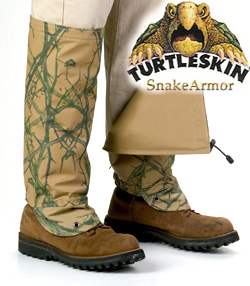
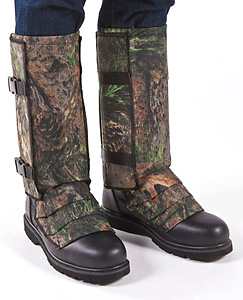
 If you've not yet attended a GPAA (Gold Prospectors Association of America) Gold & Treasure Show, the coming months provide an opportunity to rub elbows with some of the best prospectors and manufacturers in the business! Browse the show floor to find the latest and greatest gold mining and metal detecting equipment, see product demos, attend free seminars, ask questions of the pros, and enter to win door prizes. Weekend shows run 10 am - 4 pm. Presale admission is $5 by registering online or $10 at the door.
If you've not yet attended a GPAA (Gold Prospectors Association of America) Gold & Treasure Show, the coming months provide an opportunity to rub elbows with some of the best prospectors and manufacturers in the business! Browse the show floor to find the latest and greatest gold mining and metal detecting equipment, see product demos, attend free seminars, ask questions of the pros, and enter to win door prizes. Weekend shows run 10 am - 4 pm. Presale admission is $5 by registering online or $10 at the door.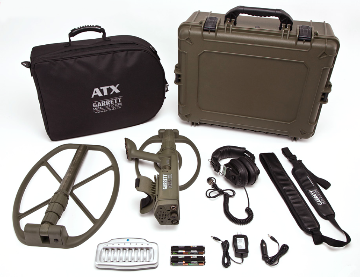
 my wrist, which gave it a perfect fit and feel, and allowed me to work all of the control buttons easily with my thumb. I pushed the unit out in front of me a bit and turned on the power switch, which is located on the back of the unit. The Garrett ATX Deepseeker Metal Detector goes through its startup and self-diagnostic test. Every light on the control pad comes on and unit emits several different sounds before settling into a comfortable, but high, threshold. This is not a turn-on-and-go detector. Either read the entire owners manual before you go out hunting, or at least read the first two pages of the manual— page 1 is the Quick Start Guide and an explanation of how to access the functions of the ATX quickly, and page 2 shows you where to find more information concerning those functions.
my wrist, which gave it a perfect fit and feel, and allowed me to work all of the control buttons easily with my thumb. I pushed the unit out in front of me a bit and turned on the power switch, which is located on the back of the unit. The Garrett ATX Deepseeker Metal Detector goes through its startup and self-diagnostic test. Every light on the control pad comes on and unit emits several different sounds before settling into a comfortable, but high, threshold. This is not a turn-on-and-go detector. Either read the entire owners manual before you go out hunting, or at least read the first two pages of the manual— page 1 is the Quick Start Guide and an explanation of how to access the functions of the ATX quickly, and page 2 shows you where to find more information concerning those functions.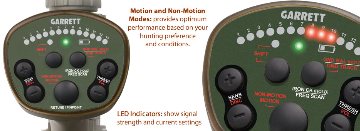 There are 5 major functions that are completely user-adjustable: Mode, Sensitivity, Threshold, Volume, and Ground Balance. Are functions are easy to adjust with a basic understanding of the ATX and more tunable as you become more proficient. Secondary functions include iron check, tracking, discrimmination and frequency shifting, to name only a few.
There are 5 major functions that are completely user-adjustable: Mode, Sensitivity, Threshold, Volume, and Ground Balance. Are functions are easy to adjust with a basic understanding of the ATX and more tunable as you become more proficient. Secondary functions include iron check, tracking, discrimmination and frequency shifting, to name only a few.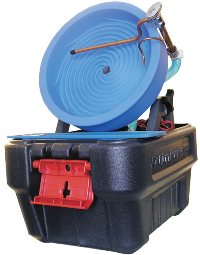
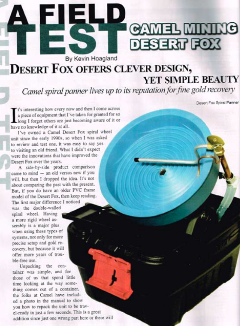
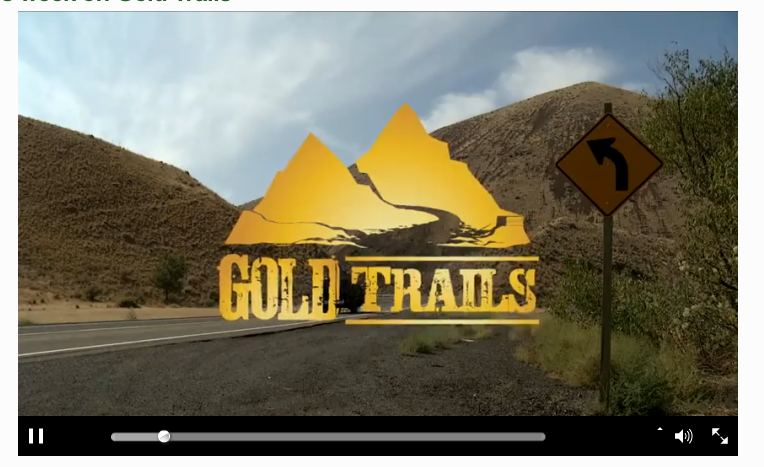
 achines worth every penny all on their own, but the value gets even better when the manufacturer puts together special holiday bundles that include extra coils and other useful items and
achines worth every penny all on their own, but the value gets even better when the manufacturer puts together special holiday bundles that include extra coils and other useful items and 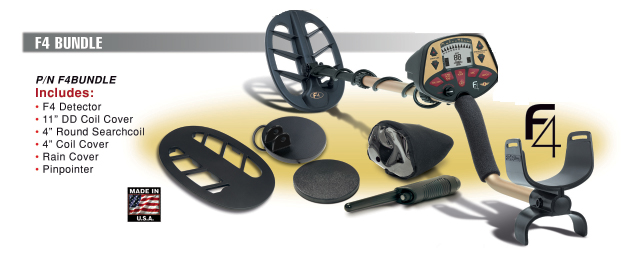
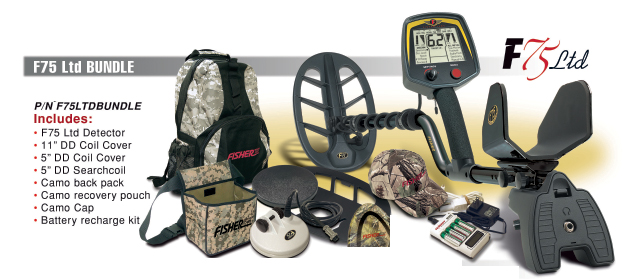

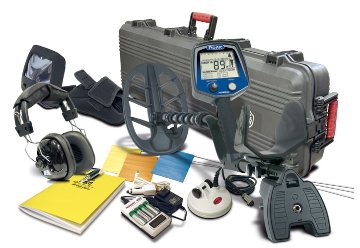
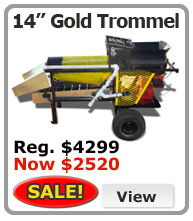 Move more material... get more gold is the best reason to upgrade your gold recovery efforts to a trommel, but now there's an even better incentive -- the
Move more material... get more gold is the best reason to upgrade your gold recovery efforts to a trommel, but now there's an even better incentive -- the 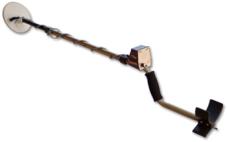

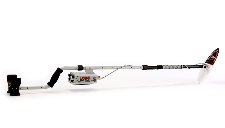 • Do you have gold fever? The Lobo Super TRAQ is an incredibly versatile, feature-rich machine that triumphs in small gold nugget prospecting. Spoil yourself with a detector that self-adjusts to any type of soil, even in highly mineralized locations. While the Lobo is designed to find gold, it also thrives in detecting coins, relics, and other treasures, too. A great value for only $679.15!
• Do you have gold fever? The Lobo Super TRAQ is an incredibly versatile, feature-rich machine that triumphs in small gold nugget prospecting. Spoil yourself with a detector that self-adjusts to any type of soil, even in highly mineralized locations. While the Lobo is designed to find gold, it also thrives in detecting coins, relics, and other treasures, too. A great value for only $679.15!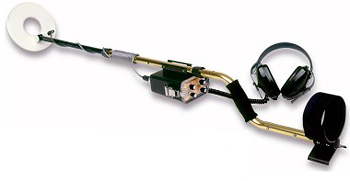

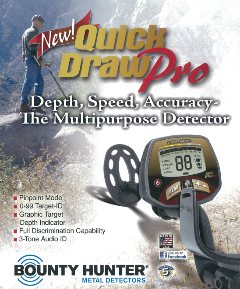
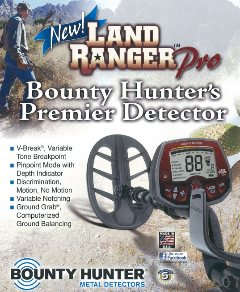
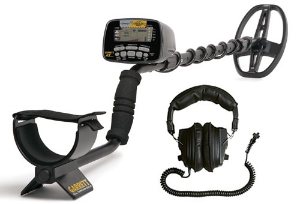 If you prefer a finer degree of control, manual ground balancing is achieved by raising and lowering the detector coil a few inches over the ground. The detector will sound off either as the coil approaches the ground or as it is raised away form the ground. The ground balance control is manipulated until there is no sound either raising or lowering the coil. The detector is now said to be ground balanced. (Always read your detector's Owners Manual, too, for instructions.)
If you prefer a finer degree of control, manual ground balancing is achieved by raising and lowering the detector coil a few inches over the ground. The detector will sound off either as the coil approaches the ground or as it is raised away form the ground. The ground balance control is manipulated until there is no sound either raising or lowering the coil. The detector is now said to be ground balanced. (Always read your detector's Owners Manual, too, for instructions.)